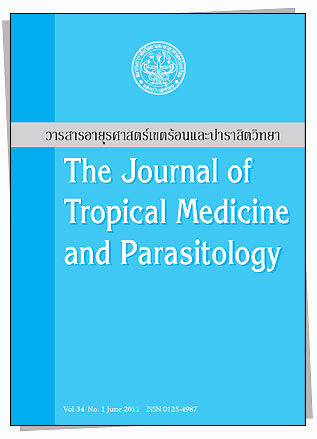Nophawan Bunchu
Department of Microbiology and Parasitology, Faculty of Medical Science, Naresuan University, Muang District, Phitsanulok 65000, Thailand
Apichat Vitta
Department of Microbiology and Parasitology, Faculty of Medical Science, Naresuan University, Muang District, Phitsanulok 65000, Thailand
Damrongpan Thongwat
Department of Microbiology and Parasitology, Faculty of Medical Science, Naresuan University, Muang District, Phitsanulok 65000, Thailand
Supaporn Lamlertthon
Department of Microbiology and Parasitology, Faculty of Medical Science, Naresuan University, Muang District, Phitsanulok 65000, Thailand
Urat Pimolsri
Department of Microbiology and Parasitology, Faculty of Medical Science, Naresuan University, Muang District, Phitsanulok 65000, Thailand
Puangphet Waree
Department of Microbiology and Parasitology, Faculty of Medical Science, Naresuan University, Muang District, Phitsanulok 65000, Thailand
Jintana Wongwigkarn
Department of Microbiology and Parasitology, Faculty of Medical Science, Naresuan University, Muang District, Phitsanulok 65000, Thailand
Boonruang Khamsri
Department of Microbiology and Parasitology, Faculty of Medical Science, Naresuan University, Muang District, Phitsanulok 65000, Thailand
Rattiya Cheewapat
Department of Microbiology and Parasitology, Faculty of Medical Science, Naresuan University, Muang District, Phitsanulok 65000, Thailand
Siriwan Wichai
Department of Microbiology and Parasitology, Faculty of Medical Science, Naresuan University, Muang District, Phitsanulok 65000, Thailand
Tusanee Meepayung
Department of Microbiology and Parasitology, Faculty of Medical Science, Naresuan University, Muang District, Phitsanulok 65000, Thailand
Aree Thongthung
Department of Microbiology and Parasitology, Faculty of Medical Science, Naresuan University, Muang District, Phitsanulok 65000, Thailand
Sittud Soypetcasem
Department of Microbiology and Parasitology, Faculty of Medical Science, Naresuan University, Muang District, Phitsanulok 65000, Thailand
Charunan Buapan
Department of Microbiology and Parasitology, Faculty of Medical Science, Naresuan University, Muang District, Phitsanulok 65000, Thailand
Polprecha Chidburee
Department of Natural Resources and Environment, Faculty of Agriculture, Natural Resources and Environment, Naresuan University, Muang District, Phitsanulok 65000, Thailand
Raxsina Polseela
Department of Microbiology and Parasitology, Faculty of Medical Science, Naresuan University, Muang District, Phitsanulok 65000, Thailand
Abstract
Abstract
The prevalence of the pinworm, Enterobius vermicularis, was determined in 4 provinces of lowernorthern Thailand (Phitsanulok, Uthai Thani, Kamphaeng Phet, and Nakhon Sawan) duringJanuary 2008-May 2010. Of the 1,131 children tested, 19.9% were positive for E. vermicularis eggsby Scotch-tape technique. The infection rate was highest among residents of Phitsanulok (25.0%),followed by Kamphaeng Phet (20.3%), Uthai Thani (17.9%), and Nakhon Sawan (13.8%). The agegroup 4-6 years had the highest positive rate. The results indicated relatively high overall infectionrates. Mass treatment and educational programs should be undertaken, to reduce re-infection inthese areas.
Keywords: Enterobius vermicularis, prevalence, children, Thailand

